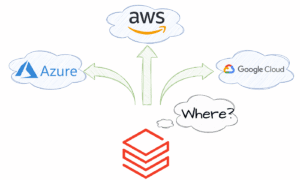Abstract
As cloud computing becomes the backbone of modern enterprises, the need for more robust and flexible security measures has grown. Zero Trust Architecture (ZTA) provides a paradigm shift from traditional perimeter-based security by assuming that no entity—inside or outside the network—should be inherently trusted. This paper explores how leading organizations such as Google, Microsoft, and AWS have implemented Zero Trust, highlighting the strategies, benefits, and challenges of their approaches. Finally, we explore the future of ZTA in cloud computing and provide actionable insights for new organizations looking to implement Zero Trust.
1. Introduction
The increasing complexity of cloud environments and sophisticated cyberattacks have necessitated a reevaluation of security strategies. Traditional perimeter-based defenses, which rely on network segmentation and trusted internal zones, are proving ineffective against advanced threats, particularly as workforces and infrastructures become more distributed. Zero Trust Architecture (ZTA) is emerging as a critical solution that enforces the principle of “never trust, always verify,” treating every request, user, and device as untrusted by default (NIST SP 800-207).
This paper presents a technical exploration of how large organizations like Google, Microsoft, and AWS have implemented ZTA within their cloud infrastructures. We will compare their architectural approaches, evaluate the strengths and limitations, and outline key lessons that can guide smaller organizations in their Zero Trust journey.
2. How Leading Companies Implement Zero Trust Architecture
2.1 Google: BeyondCorp
Google pioneered the BeyondCorp initiative, one of the earliest and most widely recognized implementations of Zero Trust. The key principle behind BeyondCorp is that trust should never be assumed based on network location (i.e., whether a user is inside or outside the corporate network).
2.1.1 Key Features
- Identity-Centric Access: BeyondCorp emphasizes user identity as the primary mechanism for controlling access. Every request is authenticated and authorized based on a combination of user identity, device status, and context, rather than relying on network segmentation or VPNs.
- Continuous Validation: Even after authentication, access is continuously validated using real-time data from the device, location, and network.
- Granular Access Control: Access control is fine-tuned to the application or resource level. Even when a user is authenticated, they may have different levels of access based on their identity, device health, or current context (BeyondCorp Research Paper).
2.1.2 Pros and Cons
Pros:
- No need for VPNs: Unlike traditional models that use VPNs to protect internal network traffic, BeyondCorp eliminates VPN dependencies, making the solution scalable across remote workforces.
- Real-time data use: Google’s approach provides real-time contextual decisions, enhancing the security of critical applications.
- Micro-Segmentation: Every application or service can have its own access policies, minimizing lateral movement risks in case of a breach.
Cons:
- Complex Integration: The integration of real-time data validation systems, granular policies, and identity management can be technically complex for organizations without Google’s resources.
- High Performance Overhead: Continuous validation and identity checks can introduce latency, especially in highly dynamic environments with thousands of user interactions.
2.2 Microsoft: Azure Active Directory Conditional Access
Microsoft has taken a more modular approach to Zero Trust with its Azure Active Directory (AAD) and Conditional Access policies. AAD forms the core of Microsoft’s Zero Trust offering, working in tandem with other cloud-native services such as Azure Sentinel and Microsoft Defender to enforce Zero Trust principles.
2.2.1 Key Features
- Conditional Access: Access to resources is controlled based on real-time conditions such as device compliance, user location, and risk level. Conditional Access policies can enforce multi-factor authentication (MFA) when certain risk thresholds are met (Microsoft Docs).
- Device Compliance: Devices accessing Azure resources are checked for compliance (e.g., security patches, endpoint protection) using Intune and Microsoft Endpoint Manager.
- Threat Intelligence: Microsoft integrates its cloud services with Azure Sentinel, a cloud-native SIEM (Security Information and Event Management) tool that continuously analyzes user behavior for potential security anomalies.
2.2.2 Pros and Cons
Pros:
- Seamless Integration: AAD integrates seamlessly with other Microsoft services, such as Office 365 and Azure Virtual Machines, providing comprehensive coverage across the Microsoft ecosystem.
- Threat Intelligence Integration: Microsoft leverages its vast telemetry and threat intelligence database to provide robust contextual analysis and anomaly detection, improving overall security.
- Scalable MFA: Conditional Access provides fine-grained control over MFA, ensuring that high-risk scenarios are mitigated (Azure Conditional Access).
Cons:
- Vendor Lock-in: Microsoft’s Zero Trust solution works best within the Azure ecosystem. Organizations using multi-cloud environments or other non-Microsoft solutions may find integration more challenging.
- Customization Overhead: Fine-tuning Conditional Access policies for specific organizational needs can require significant expertise in AAD and related services.
2.3 AWS: Zero Trust Architecture with AWS Identity and Access Management (IAM)
Amazon Web Services (AWS) offers a highly flexible, but more fragmented approach to Zero Trust through services like AWS Identity and Access Management (IAM), Amazon GuardDuty, and AWS PrivateLink. AWS’s Zero Trust solution is built around the principles of granular IAM policies and secure communication channels.
2.3.1 Key Features
- IAM and Role-Based Access Control (RBAC): AWS IAM enables fine-grained role-based access controls. Each IAM role or user is assigned the minimum set of permissions necessary for the task, enforcing the principle of least privilege.
- PrivateLink and VPC Endpoint Services: AWS PrivateLink enables secure, private communication between services by keeping data within the AWS network, reducing the need for public IP exposure. This is particularly useful in enforcing Zero Trust principles for sensitive data.
- Monitoring and Logging with GuardDuty: AWS integrates monitoring and continuous threat detection via GuardDuty, providing real-time alerts for anomalies or unauthorized access attempts.
2.3.2 Pros and Cons
Pros:
- Highly Customizable: AWS provides a range of services that can be combined in different ways to meet specific organizational needs, offering flexibility for diverse use cases.
- Service-Level Isolation: AWS PrivateLink allows organizations to isolate sensitive services from public access, significantly reducing the attack surface.
- Scalability: AWS’s ZTA can scale seamlessly with an organization’s growth due to its cloud-native approach, making it suitable for enterprises of all sizes (AWS Zero Trust Security).
Cons:
- Complexity in Design: The fragmented nature of AWS’s Zero Trust services (IAM, PrivateLink, GuardDuty) means that organizations need to carefully design their security architecture, which may be resource-intensive.
- Cost Overheads: Using multiple AWS services (IAM, VPCs, GuardDuty, etc.) can lead to high operational costs, especially for smaller organizations with constrained budgets.
3. Challenges and Future Directions of Zero Trust in Cloud Environments
3.1 Challenges
- Interoperability: Implementing ZTA across multi-cloud environments remains a significant challenge. Each cloud provider has its own security model, tools, and policies, making consistent enforcement of Zero Trust principles difficult.
- Performance and Latency: As discussed in Google’s BeyondCorp and AWS’s solutions, the continuous authentication and monitoring inherent to ZTA can lead to performance bottlenecks. This is a particularly critical issue for latency-sensitive applications like financial services or real-time communications.
- User Experience: Overzealous enforcement of Zero Trust principles can degrade the user experience, especially when multi-factor authentication or identity checks are frequent.
3.2 Future Directions
- Automation and AI: As organizations scale, automation and AI-driven decision-making will become crucial for ZTA. Real-time anomaly detection, behavior-based policy enforcement, and automated threat responses will reduce the manual overhead of managing Zero Trust policies.
Standardization Across Cloud Providers: Efforts like the Open Policy Agent (OPA) and Cloud Security Alliance (CSA) aim to standardize Zero Trust implementations across cloud environments. This will allow organizations to implement ZTA across AWS



































